Performance evaluation of a modified step-feed anaerobic/anoxic/oxic process for organic and nutrient removal
A.R.Majdi Nasab,S.M.Soleymani,M.Nosrati*,S.M.Mousavi
Biotechnology Group,Faculty of Chemical Engineering,Tarbiat Modares University,Tehran,Iran
1.Introduction
More and more progressive wastewater treatment technologies are needed to protectthe limited water sources owing to increasing the eutrophication and urbanization of receiving waters,especially slow mobile rivers and lakes[1].Organic and surplus nutrients in wastewater,especially nitrogen and phosphorus,must be widely removed prior to discharging into natural bodies of water[2,3].In comparison with physical-chemical procedures,biological methods are recommended to treat municipal wastewater in terms of simultaneous removal of phosphorus and nitrogen,as well as cost and energy savings[4-6].However,usual biological nutrient removal(BNR)processes have often become inoperative in simultaneously maximizing nutrient and organic removal,as heterotrophic bacteria,nitrifying autotrophic bacteria and phosphorus accumulating organisms(PAOs)compete with each other for growth and maintenance under the same operational circumstances[7-9].To date,several biological processes related to activated sludge have been generally adopted in wastewater treatment plants(WWTP),such as anaerobic/anoxic/oxic(A/A/O),pre-denitrification(A/O)and the “University of Cape Town”(UCT)method[2,10].However,modifications in such biological nutrient removal activated sludge(BNRAS)systems have demonstrated that step-feeding is a considerable process in removing internal recycling and sludge recirculation,as well as to optimize organic carbon for denitrification[11,12].These processes display relatively good nutrient removal efficiencies in treating wastewater with adequate carbon sources or high chemicaloxygen demand to total nitrogen ratio(COD/TN)[13,14].However,phosphorus and nitrogen removal efficiency would be deteriorated if influent COD concentrations are inadequate for releasing phosphorus or denitrification[15-17].
The modified UCT process is qualified to sustain a fully anaerobic environmentdue to increasing the internalrecycle subsystem to minimize the inhibitory in fluence of nitrate to the reaction of anaerobic phosphorous released by PAOs[9,18].The process is also beneficial to the attainment of anoxic denitrifying phosphorus removal;thereby enhanced phosphorus removal could be achieved with a significant devaluation in the total necessity of organic substrates[19,20].
A modified step-feed process,which combines the benefits of stepfeed A/O process and UCT process together,is proposed for increasing both phosphorus and nitrogen removal efficiency in this study.This process consists of an anaerobic selector zone followed by three uniform pairs of anoxic and aerobic zones with the elimination of a preliminary sedimentation tank.As performance and operation of the modified step-feed process in wastewater treatment plants,including nutrients removal,are much more complicated compared to those of conventional treatments,this study contributes to a)investigating the sufficiency of modified step-feed treatment in COD,nitrogen and phosphorous removal through given volume ratios of anaerobic(1.35),anoxic(1)and aerobic(1.50)compartments and,b) finding quantitative relations between in flow distribution ratios in anoxic zones and COD and nitrogen contents in the outlet stream.
2.Materials and Methods
2.1.The pilot-plant step-feeding system
A lab-scaled step-feed reactor consisting of seven segments in sequence-each made of colorless Plexiglass-was used in this study as illustrated in Fig.1.The reactor was constructed with a working volume of 22.32 L comprising an anaerobic selector(3.42 L)followed by a series of three uniform pairs of aerobic regions(3.78 L)and anoxic regions(2.52 L).The volume ratio of anaerobic/anoxic/oxic was 1.35:1:1.5.An air compressor was utilized to supply the required oxygen which provided sufficient gas-liquid mixing in all aerobic regions,whereas appropriate liquid mixing was obtained in anaerobic and anoxic regions by using four mixers in anaerobic and anoxic zones,respectively.The in fluent flow was divided into three streams prior to entering the anaerobic region,the second anoxic region and the third anoxic region.Those streams that fed into the beginning(anaerobic zone)remain in the reactor for longer and consequently have more time to achieve better treatment(COD removal);whereas,those streams that enter in the middle,or at the last anoxic zone,help denitrification through carbon source supply(nitrate removal).According to this fact,three distribution ratios including 60/25/15,40/35/25 and 25/35/40 were examined in order to investigate their effect on phosphorous,nitrogen,and COD removal in the outlet stream.In order to achieve stable performance,feeding to the reactor was carried out for one week after alternating each of the in flow distribution ratios.Therefore,steady state conditions were obtained after one week feeding the reactor by the new in flow distribution ratio.
All the in flow rates were regulated by altering the rotational speeds of the peristaltic pumps.Two used influent flow rates,1.44 L·h-1and 1.80 L·h-1,resulted in hydraulic retention times(HRT)of 16 h and 12 h,respectively.The sludge was recycled from the clarifier to the first anoxic region in order to decrease the concentration of nitrate that existed in the returned sludge.In the aerobic regions,air was conveyed by bubble diffusers installed at the bottom of the reactor resulting in appropriate mixing in the aerobic zones.The temperature was maintained at room temperature(24-28°C).The resulting mixed liquor suspended solids(MLSS)was in the range of 5000-5500 mg·L-1,and mixed liquor volatile suspended solids(MLVSS)concentration was 3200 mg·L-1.In the aerobic regions,DO values were maintained between 2 and 2.5 mg·L-1,while DO values were maintained at about 0.25 mg·L-1and 0.5 mg·L-1for anaerobic and anoxic regions,respectively.The sludge recycle ratio was held constant at 60%.The experimental runs comprised total in flow rates,in flow distribution ratios and HRTs,as well as COD,BOD,-N and-P loading rates,are summarized in Table 1.
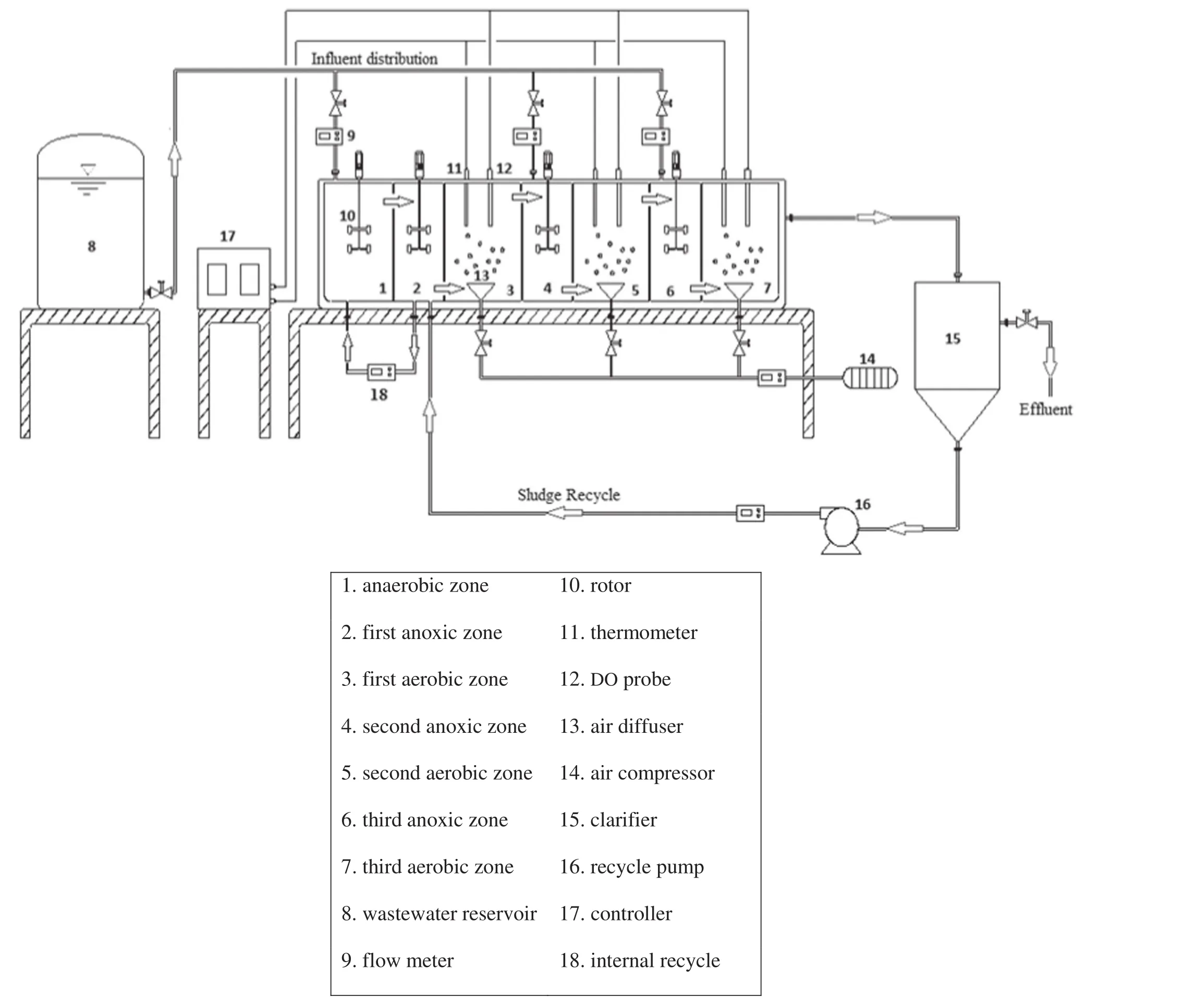
Fig.1.Schematic representation of the experimental set up.
2.2.Seed sludge and wastewater characteristics
The seed sludge was taken from the aerobic region of the full scale reactor of the Tehran South WWTP,where biological nitrogen and chemical phosphorus removal were obtained,respectively.The reactor in Tehran South WWTP(450000 m3·d-1)is a Carrousel biological nutrient removal and had been under operation for about four years.
After a one-month cultivation period of the activated sludge and its adaptation to the synthetic wastewater,a permanent denitrifying operation was obtained and the process performance was stabilized.Two kinds of synthetic wastewater with the concentration and characteristics of real domestic wastewater were fed to the reactor: first,a normal wastewater with total COD of 300 mg·L-1and,second,a thickened wastewater with total COD of 500 mg·L-1.
2.3.Analytical methods
The pH and temperature were found using WTW level-2 pH meters(WTW Company,Germany).Further,DO values were detected by WTW,pH/oxi340i meters with fully equipped DO sensors and calibration facilities.COD,BOD,,,,TN,MLSS and volatile MLSS concentrations were analyzed according to standard methods[21].COD solutions have been heated by a special stainless steel heater B75hls(WEL Company,Japan)for the analyses of COD concentration in each experimental period.
3.Results and Discussion
3.1.Effect of different in flow distribution ratios on the performance of nutrients removal
Figs.2-6 display the influent and effluent concentrations coupling with removal performances of,,TN,and COD during nine operational runs,respectively.The influent distribution ratio had a significant effect on the rate of COD andremoval(Figs.2(a)and 6(a)).It is obvious that by entering the third part of the influent distribution ratio to the last anoxic zone,nitrifiers became considerably active,so total nitrification was obtained during the whole experimental period in the influent distribution ratio of 60/25/15 in both COD concentrations of 300 and 500 mg·L-1.Therefore,a remarkable variation was observed in COD andconcentrations through one to nine runs while the influent COD varied from 500 to 300 mg·L-1(Figs.2(a)and 6(a)).Furthermore,most of the influent COD concentration was consumed in the anoxic or anaerobic regions.This was considered as an advantageous condition for nitrification due to the observed residual COD inhibitory effect elimination.
The effluent COD concentration increased while total influent flow rose from 1.44 L·h-1to 1.80 L·h-1in all influent distribution ratios,and this event was more visible in the in flow distribution ratio of 25/35/40(Fig.6(b)).As shown in Fig.2(b),concentration fluctuated between 2.24 and 9.20 mg·L-1during three different distribution ratios,while total influent flow was 1.80 L·h-1.The averageremoval rate was 85%,with a maximum of 95%.The result was in accordance with the research by Geet al.[6],who remarked that the ratio for the first stage of the modified step-feed process over 50%would lead to negative effects on nitrification and nitrogen removal.In addition,exceeding the influent may bring about supplementary carbon sources being oxidized in the following oxic zones if it is not fully consumed in the anaerobic and anoxic segments.Therewith,reduction in the existing carbon sources available in the second and third anoxic zones resulted in an enhancement in effluent TN owing to a lack of necessary organics required for heterotrophic denitrifying nitrogen removal.Moreover,there was a relatively positive relationship between in flow to anaerobic,second and third anoxic segments and anaerobic phosphorus release.Anaerobic phosphorus release could be negatively impressed by the availability of excess nitrate and insufficient influent organic compounds.
Thus,another progressive strategy was obtained by incorporating the step-feed process and the modified UCT biological nutrient removal method together to prevent the detrimental effects of nitrate existence on phosphorus release.In the modified step-feed type,a part of the excess nitrate was reduced to nitrogen gas by the initial movement of sludge returned mixed liquor between the clarifier unit and the first anoxic segment.Moreover,the minor current of the mentioned mixed liquors with less nitrate concentrations was recycled to the anaerobic segment,at which point slightly more anaerobic conditions were prepared due to phosphorus release.As a result,the enhancing phosphorus release and removal efficiency were obtained with less nitrate concentrations in the anaerobic region as had been expected.The PO34-removal efficiency ranged significantly between 39%and 79%with an average value of 62%during the whole experimental period(Fig.5(a)).Arecentresearch remarked the magnitude of desirable operating conditions and influent concentrations for the processes coupled with successful phosphorus removal[22].
As a result,higher influent ratios to the anaerobic and anoxic regions represented that more carbon sources would be accessible in anaerobic and anoxic segments where high carbon sources for denitrification and anaerobic phosphorus release have been prepared.Generally,higherinfluent ratios to the anaerobic segment would be advantageous to phosphorus uptake,whereas a ratio higher than a certain level results in negative effects on nitrogen elimination[6].

Table 1Operational process conditions,sludge loading rates(F/M),influent loading rates for organic,phosphorus and nitrogenous substrates in each run

Fig.2.Effluent ammonium concentration and removal efficiency regarding(a)total influent COD concentration,and(b)total in flow rate.
As a consequence,the optimum in flow distribution ratio would be desired to improve nutrient removals.The optimum in flow ratios should be regulated to make more COD to be consumed for phosphorus release during the anaerobic region and denitrification zones.Consequently,this event leads to a reduction in common intrusion of residual COD to nitrification and attempts to decrease the aeration consumption in aerobic regions.
Larreaet al.[4]reported that the optimal in fluent distribution ratio to the three inlet regions of the reactor was in the range of 40/40/20 and 33/33/34,which frequently concerns effluent requirements and wastewater characteristics.Funamizuet al.[23]declared that the selection of the step-feed ratio alone was not enough to enhance nitrogen removal due to low denitrification rates in anoxic segments.Table 2 has classified and compared several previous researches that have been conducted on a variety of step-feed processes with different influent distribution ratios and configurations.
Fig.4(a)and(b)illustrates the trend of total nitrogen(TN)concentration and removal efficiency.In this study,total nitrogen is the summation of effluent-N and-N concentrations during each run.The average effluent TN removal efficiency was76.16%with the average effluent TN concentration of4.34 mg·L-1during all experiments.As the results indicated,a high TN removal rate leads to a high phosphorus removal rate.Table 3 has been prepared to better understand the figures.
According to Fig.4(b),TN removal efficiency decreased as the in flow to the last anoxic segment grew,both in total in flow of 1.44 and 1.8 L·h-1.Consequently,this event has occurred due to the availability of high carbon sources in pre-anoxic zones(particularly the last anoxic region),resulting in weak nitrification in the last aerobic segment and high effluent ammonium concentration,which led to high effluent TN.Most likely,low HRT may be another reason for the mentioned event due to the high level of influent in the last pre-anoxic zone in the last influent distribution ratio(25/35/40).Accordingly,more anoxic denitrification rates would be obtained at limited HRTs,which had clear a positive correlation with TN removal[24,25].
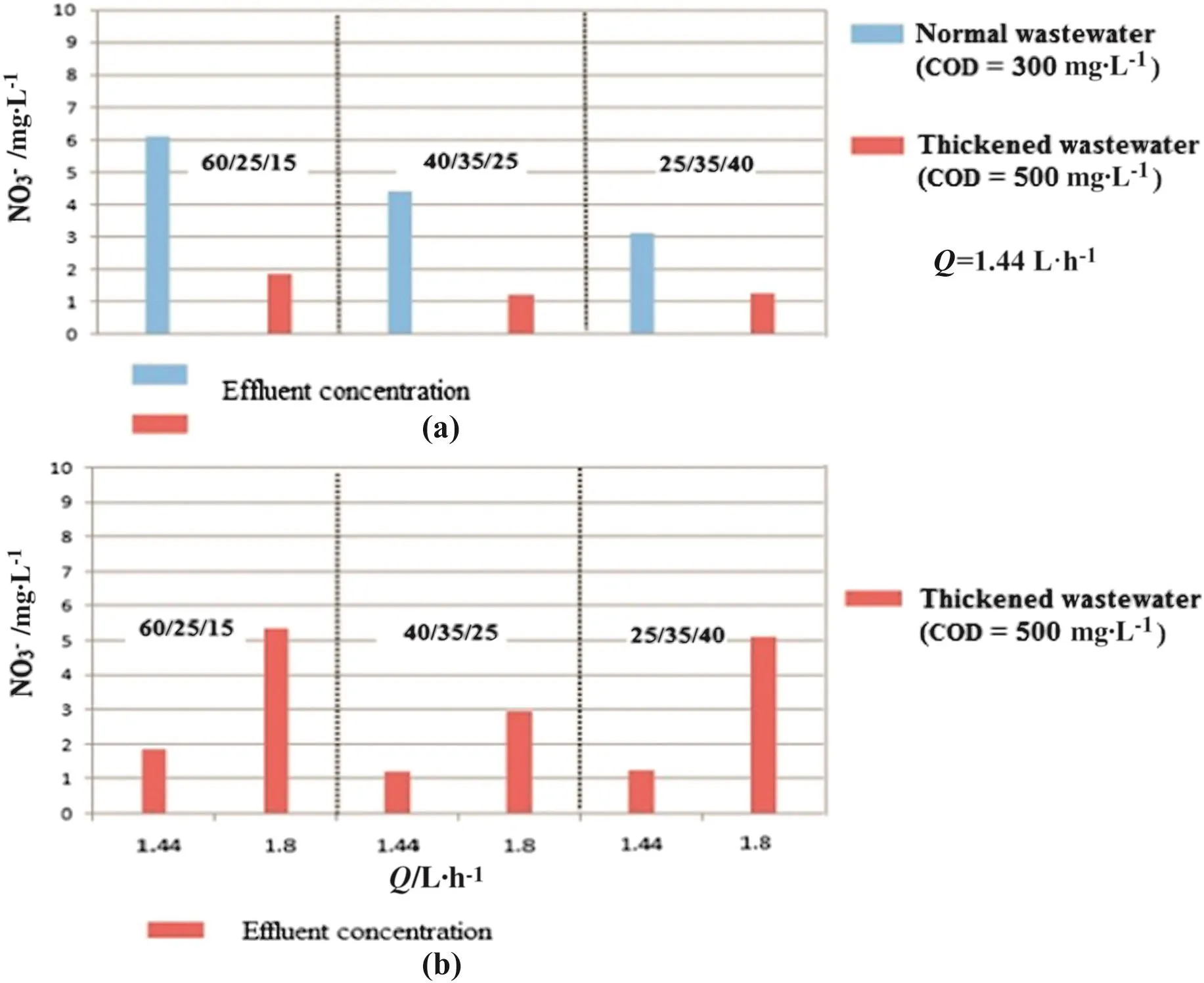
Fig.3.Effluent nitrate concentration regarding(a)total influent COD concentration,and(b)total in flow rate.
3.2.Organic and nutrient removal procedures
3.2.1.COD removal
COD concentration and removal efficiency in different stages and under different operational situations are illustrated in Fig.6.Results indicated that the influent COD distribution had a significant effect on denitrification capability and anaerobic phosphorus release.The residual COD trended to increase from 64 mg·L-1in the in flow rate of 1.44 L·h-1to 87 mg·L-1in the in flow rate of 1.8 L·h-1in the ratio of 25/35/40 according to Fig.6(b).This event was established for two other ratios,although it was significantly observed during the ratio of 25/35/40 due to low HRT and a high ratio to the last pre-anoxic zone.Consequently,it caused different anaerobic phosphorus release capabilities and removal performances.Moreover,the COD utilization capacity for phosphorus and nitrogen removal varied with changing the in flow distribution ratios.Although in the in flow distribution ratio of 60/25/15 HRT was the maximum amount,the highest effluent COD removal efficiency was observed during the ratio of 40/35/25(Fig.6(a)).In addition,this maximum organic removal efficiency was simultaneously coupled with maximum nitrate removal efficiency due to the high anoxic denitrification rate.
Accordingly,the results displayed that enhancement in COD removal efficiency directly related to the improvement in nitrate removal efficiency.In other words the more denitrification takes place,the more organics are eliminated owing to denitrifying phosphorus and nitrate removal.The performance of COD removal failed in the ratio of 25/35/40 owing to low HRT.Additionally,as expected the effluent COD concentration increased while the wastewater in flow rate and concentration enhanced.This enhancement in effluent COD was more visible in the ratio of 25/35/40,which demonstrated that in two other distribution ratios the process was more capable to adapt itself to the wastewater in flow rate and concentration enhancement.
3.2.2.Phosphorus removal
Fig.5 illustrates effluentconcentration and removal efficiency during different experimental periods under different operational conditions.Results displayed that anaerobic HRT had a distinct effect on anaerobic phosphorus release,based on observations during the experimental period.As expected,PAOs was capable of eliminating the degradable organic substrates to produce polyhydroxyalkanoates(PHA)with the reserved polyphosphate(poly-P)utilized as an energy source[26].As a result,it could be concluded that the aerobic/anoxic phosphorus removal directly relies on the mechanisms of phosphorus release under anaerobic conditions in the first stage.In addition,sustaining an appropriate microorganism population in the anaerobic segment should not be neglected.In order to enrich the convenient population,more in flow organic concentrations are required.
Wanget al.[27]reported that the highest anaerobic phosphorus release was 350%and 497%of the influent total phosphorus(TP)concentration,and achieved significantly high TP uptake.Maximum phosphorus removal efficiency was observed in the in flow distribution ratio of 60/25/15,which prepared the required organics according to Fig.5(a).Therewith,significant phosphorus uptake was obtained in anoxic zones in the mentioned ratio,which might be attributed to denitrifying phosphorus removal.Afterwards,the majority ofwas further eliminated under aerobic conditions in the oxic 1 segment,while the minor amount ofwas removed in the oxic 2 and oxic 3 segments,respectively.

Fig.4.Effluent total nitrogen concentration and removal efficiency regarding(a)total influent COD concentration,and(b)total in flow rate.
Wachtmeisteret al.[28]remarked that virtually 32.6%-39.5%of DNPAOs were responsible for PAOs imputed to favorable phosphorus uptake capacity under appropriate distribution ratios.
Once in anaerobic zones sufficient accessible organic substrates were confected for PAOs releasing phosphorus and producing storable carbon source PHA,the anoxic/oxic phosphorus elimination process and denitrification would be obtained in the subsequentanoxic/oxic regions,as Kapagiannidiset al.[29]reported in their recent research.However,convenient phosphorus release would run against an adverse effect by the availability of nitrate in the recycled sludge stream,resulting in a significant weakness in the optimal anaerobic conditions required for PAOs to release phosphorus.Therefore,the returned sludge should be recycled to the first anoxic zone to reduce the amount of accessible nitrate,primarily,prior to entering the anaerobic zone.
3.2.3.Nitrogen removal
The alteration of NH4+,NO3-and TN along the experimental period under different operational conditions is illustrated in Figs.2,3,and 4,respectively.As results indicated,less influentN loads,adversely decayed nitrification qualification in oxic 1 and oxic 2.Meanwhile,the results confirmed that moreuptake was observed in the preanoxic regions,attributed to the dissolved oxygen transportation from aerobic segments resulting in partial oxidation of available carbon sources which were not conductive to TN elimination.Probably,this could be a logical reason for comparing the restricted TN uptake with 83%TN removal efficiency demonstrated in Vaiopoulou and Aivasidas(2008)in comparison with Geet al.(2010)who demonstrated TN removal efficiency of 88%.
Nitrification was fully accomplished during all steady-state experiments except in the low HRT runs.The average removal efficiency of NH4+and TNwere 82%and 78.6%,respectively,during the whole experimental period.Moreover,a possible advantageous parameter to desirable nitrogen removal in the step-feed process was the occurrence of simultaneous nitrification and denitrification(SND).To be more informed about the significance of the SND in TN removal,a summarized discussion should be held in order to make the subject more explicit.Generally,the total mass of nitrogen available in the influent entering the treatment process could be utilized according to the following fractions:(1)cell growth and synthesis attributed to the waste activated sludge;(2)proportion of nitrate to nitrite and TN in effluent;and(3)N2gas released through denitrification process along anoxic or,probably,aerobic regions[30].
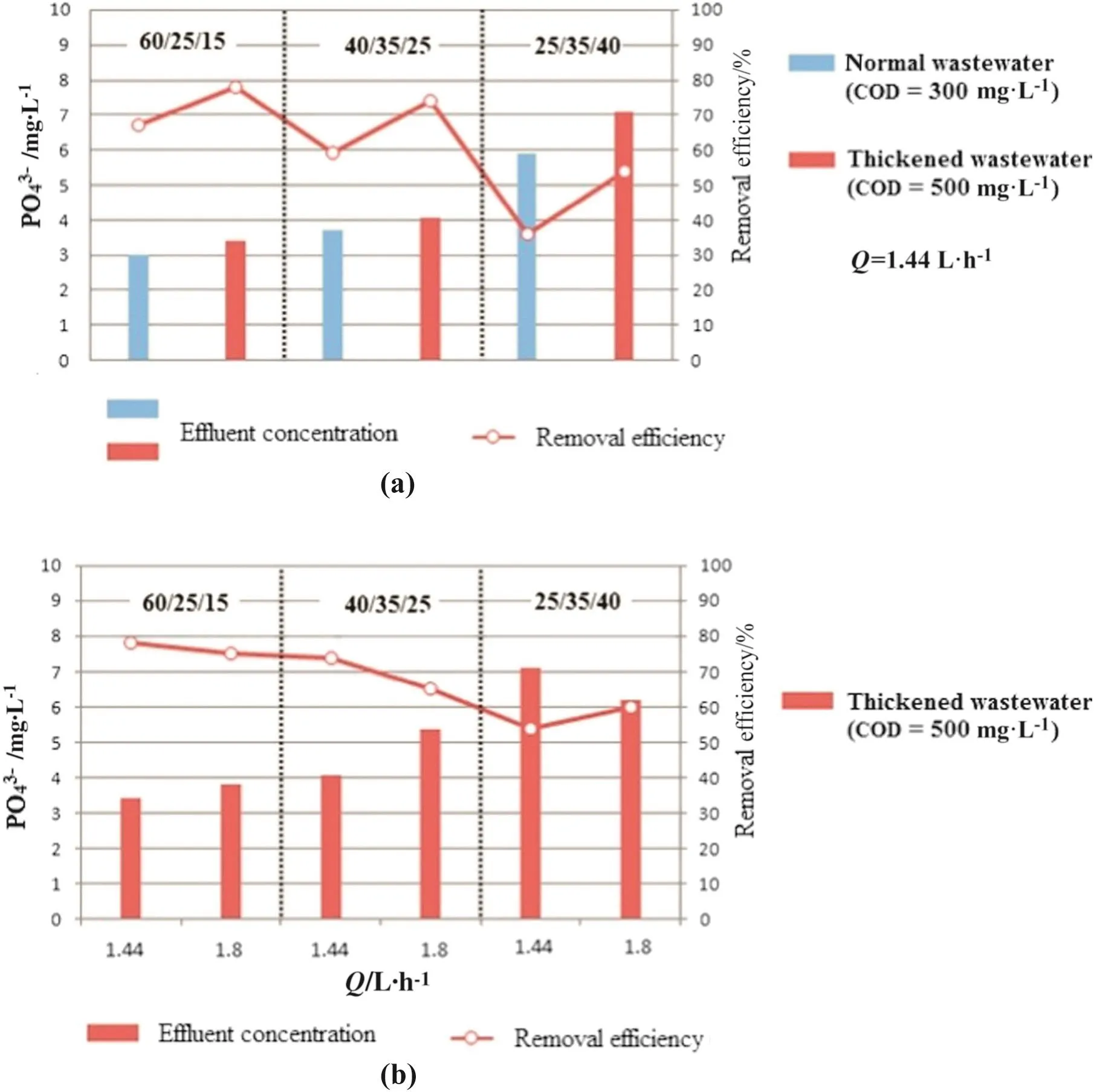
Fig.5.Effluent phosphate concentration and removal efficiency regarding(a)total influent COD concentration,and(b)total in flow rate.
The anoxic denitrification sufficiencies play eminent roles in TN elimination,owing to the fact that the possibility of reducing-N and-N to nitrogen gas and other volatile nitrogen oxides solely exists in anoxic zones as Zhuet al.[2]and Fueet al.[31]reported in their recent studies.It could be concluded that as the in flow ratio to the anaerobic zone is enhanced,the required HRT for nitrification was established,whereas by enhancing the in flow ratio to the lastanoxic region the HRT became lower and ammonium was left in the reactor prior to being converted into nitrate.
Moreover,the total in flow rate enhancement had no distinct effect on effluent ammonium,illustrating that the bioreactor had the ability to eliminate more values of ammonium if total in flow was divided between the different stages,appropriately.If ammonium removal efficiency improvement is desired in the optimum in flow distribution ratio,alkalinity and dissolved oxygen concentration should be increased.In fact,the nitrification rate improves by increasing pH up to virtually eight,resulting in significant ammonium removal efficiency.Additionally,more dissolved oxygen concentrations and also more fluid mixing through aerobic segments provide more supplied oxygen inside the sludge flocs,resulting in ammonium concentration even below 1 mg·L-1in the effluent.
According to Fig.3,maximum nitrate removal efficiencies were obtained in the in flow ratio of 60/25/15 in comparison with the two other ratios.Low HRTs led to higher effluent nitrate concentration.In fact,nitrification required more retention time;however,by enhancing the total in flow rate this goal was inaccessible(Fig.3(b)).
3.3.COD variations along different aerobic stages
Variation of COD in all aerobic regions under different operational conditions was investigated in this study as shown in Fig.7.As results indicated,COD removal mostly occurred in N1which was similar in all in flow ratios;however,the differences in COD removal performanceviaaerobic zones among different in flow ratios were started upon entering the following aerobic zones after N1.Maximum COD removal performance could be interpreted according to significant COD utilizationviaanaerobic phosphorus release and anoxic denitrification(in the first anoxic zone).Moreover,in the in flow ratio of 25/35/40,the major ratio of feed was entered into the last anoxic zone,resulting in low COD removal qualification in N3output with the mean concentration value of 88 mg·L-1in all total influent COD values,according to Fig.7.
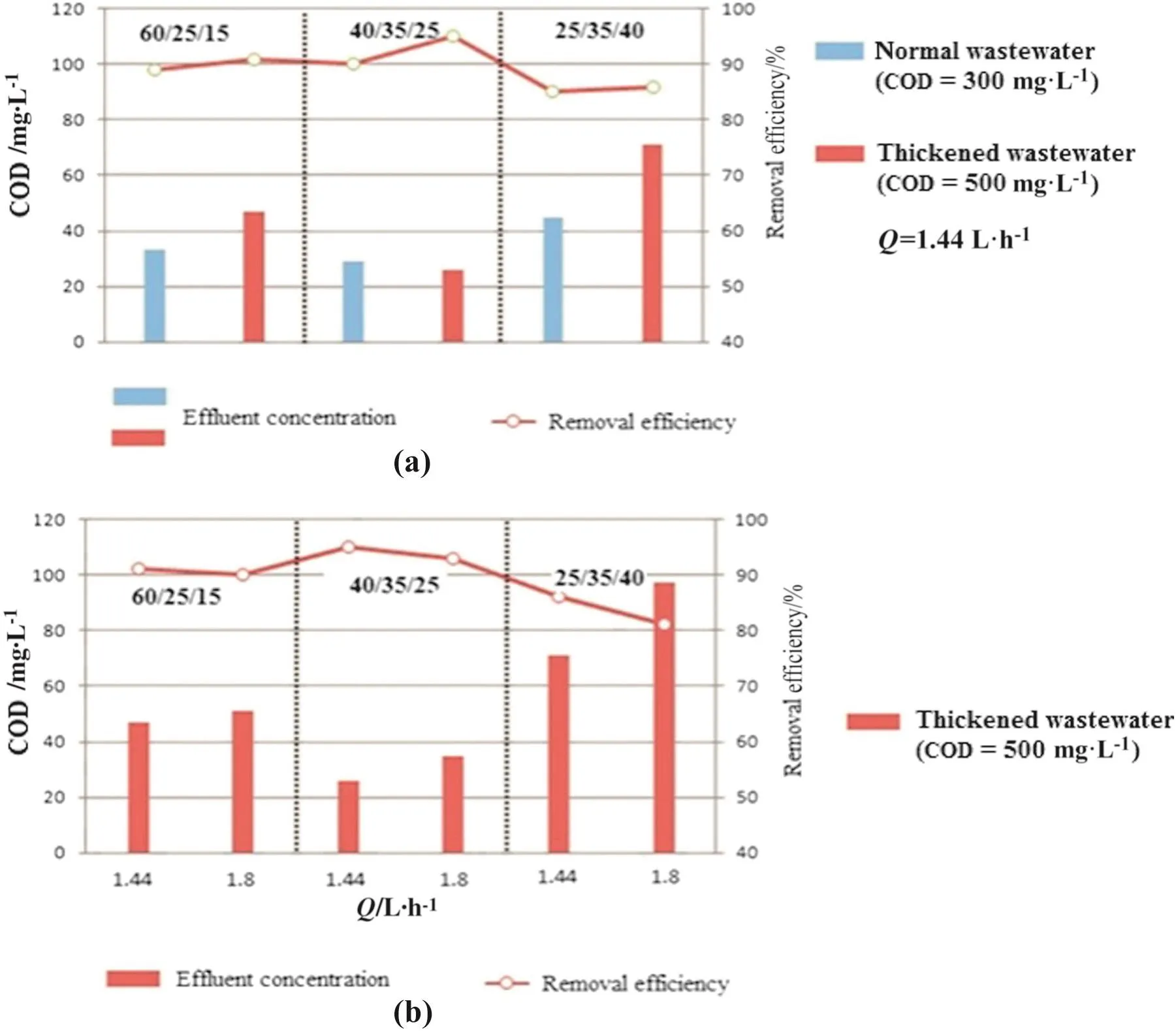
Fig.6.Effluent COD concentration and removal efficiency regarding(a)total influent COD concentration,and(b)total in flow rate.
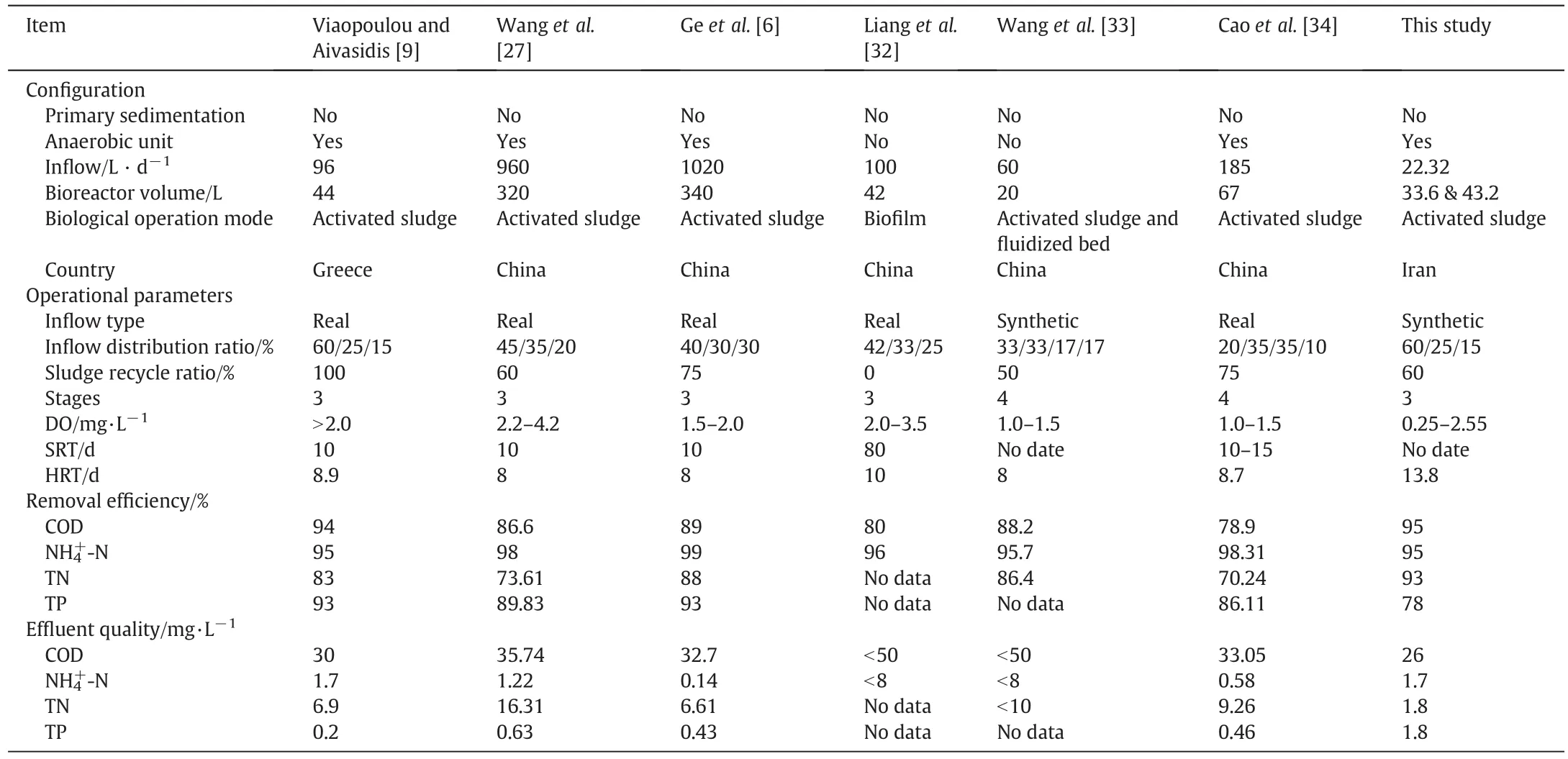
Table 2Comparisons of configurations,operational parameters and performance of the step-feed process

Table 3A guideline for making the figures more obvious

Fig.7.COD values during various aerobic stages under different operational conditions:INF—influent wastewater;N1—the first oxic zone;N2—the second oxic zone;N3—the third oxic zone.
The mean COD values throughout aerobic zones during the three inflow ratios were 433.3,131.1,104.43 and 55.55 mg·L-1for influent wastewater,N1,N2and N3,respectively.According to the results,optimum in flow ratio for favorite COD removal with high efficiency was 40/35/25,which is exactly visible in Fig.6 as well.However,total COD concentrations and removal efficiencies during the aerobic regions significantly relied on DO concentrations,which were completely discussed in the previous section.
4.Conclusions
Compared to other BNR processes,the modified step-feed process was found to be an attractive choice for urban wastewater treatment.Maximum organics andremoval were achieved in the ratio of 40/35/25 with the optimum COD removal efficiency of 95%,whereas maximum-P,TN andremoval were obtained in the ratio of 60/25/15 with the optimum efficiency of 78%,93%and 95%,respectively.p H attained convenient values,which were suitable for P-release,denitrification and nitrification during the experimental period.According to the optimum operational conditions,the process was considerably advantageous for both anaerobic P-release and anoxic/aerobic P-uptake,and TN removal efficiency could be significantly improvedviathe nitrification and denitrification processes.
Acknowledgments
The authors would like to acknowledge Mahab Ghodss Company for their extensive cooperation.
[1]Eddy Metcalf,Wastewater engineering:Treatment and reuse,McGraw Hill,New York City,USA,2003.
[2]G.B.Zhu,Y.Z.Peng,B.K.Li,J.H.Guo,Q.Yang,S.Y.Wang,Biological removal of nitrogen from wastewater,Rev.Environ.Contam.Toxicol.192(2008)159-195.
[3]H.M.Zhang,X.L.Wang,J.N.Xiao,F.L.Yang,J.Zhang,Enhanced biological nutrients removal using MUCT-MBR,Bioresour.Technol.100(2009)1048-1054.
[4]L.Larrea,A.Larrea,E.Ayesa,J.C.Rodrigo,M.D.Lopez-Carrasco,J.A.Cortacans,Development and vertification of design and operation criteria for the step feed process with nitrogen removal,Water Sci.Technol.43(2001)261-268.
[5]G.H.Cao,Y.Huang,Y.Pan,The problems and the solutions of conventional biological nitrogen and phosphorus processes,Technol.Water Treat.25(2009)102-106.
[6]S.J.Ge,Y.Z.Peng,S.Y.Wang,J.H.Guo,B.Ma,L.Zhang,X.Cao,Enhanced nutrients removal in a modified step feeding process treating municipal wastewater with different in flow distribution ratios and nutrients ratios,Bioresour.Technol.101(2010)9012-9019.
[7]J.A.Baeza,D.Gabriel,J.Lafuente,Improving the nitrogen removal efficiency of an A2/O based WWTP by using an on-line Knowledge Based Expert System,Water Res.36(2002)2109-2123.
[8]E.Viopoulou,P.Melidis,A.Aivasidis,An activated sludge treatment plant for integrated removal of carbon,nitrogen and phosphorus,Desalination211(2007)192-199.
[9]E.Viopoulou,A.Aivasidis,A modified UCT method for biological nutrients removal:Configuration and performance,Chemosphere72(2008)1062-1068.
[10]L.M.C.Daniel,E.Pozzi,E.Foresti,F.A.Chainalia,Removal of ammonium via simultaneous nitrification-denitrification nitrite-shortcut in a single packed bed batch reactor,Water Sci.Technol.25(1992)241-247.
[11]S.Schlegel,Operational results of wastewater treatment plants with biological N and P elimination,Water Sci.Technol.25(1992)241-247.
[12]T.Y.Pai,Y.P.Tsai,Y.J.Chou,H.G.Leu,C.F.Ouyang,Microbial kinetic analyses of three different types of EBNR process,Chemosphere55(2004)109-118.
[13]K.A.Third,N.Burnett,R.Cord-Ruwisch,Simultaneous nitrification and denitrification using stored substrate(PHB)as the electron donor in an SBR,Biotechnol.Bioeng.83(2003)706-720.
[14]D.Kim,K.Y.Kim,H.D.Ryu,K.K.Min,S.I.Lee,Long term operation of pilot-scale biological nutrients removal process in treating municipal wastewater,Bioresour.Technol.100(2009)3180-3184.
[15]T.Mino,M.C.M.Van Loosdrecht,J.J.Heijnen,Microbiology and biochemistry of the enhanced biological phosphate removal process,Water Res.32(1998)3193-3207.
[16]T.Shoji,H.Satoh,T.Mino,Quantitative estimation of the role of denitrifying accumulating organisms in nutrient removal,Water Sci.Technol.47(2003)23-29.
[17]J.H.Gau,Y.Z.Peng,S.Y.Wang,Y.N.Zheng,H.J.Huang,Z.W.Wang,Long-term effect of dissolved oxygen on partial nitrification performance and microbial community structure,Bioresour.Technol.100(2009)2796-2802.
[18]H.Y.Chang,C.F.Ouyang,Improvement of nitrogen and phosphorus removal in the anaerobic-oxic-anoxic-oxic(AOAO)process by stepwise feeding,Water Sci.Technol.42(2000)89-94.
[19]T.Kuba,M.C.M.Van Loosdrecht,F.A.Heijnen,Occurrence of denitrifying phosphorus removing bacteria in modified UCT-type wastewater treatment plants,Water Res.31(1997)777-786.
[20]K.Osrggard,M.Christensson,E.Lie,K.Jonsson,T.Welander,Anoxic biological phosphorus removal in a full-scale UCT process,Water Res.31(1997)2719-2726.
[21]APHA,Standard methods for the examination of water and wastewater,21st ed.American Public Association,Washington,DC,USA,2005.
[22]D.Mullkerins,A.D.W.Dobson,E.Colleran,Parameters affecting biological phosphate removal from wastewaters,Environ.Int.30(2004)249-259.
[23]N.Funamizu,S.Yamamoto,Y.Kitagawa,T.Takakuwa,Simulation of the operational conditions of the full-scale municipal wastewater treatment plant to improve the performance of nutrient removal,Water Sci.Technol.36(1997)9-18.
[24]J.Carrea,T.Vicent,J.Lafuente,Effect of influent COD/N on biological nitrogen removal(BNR)from high-strength ammonium industrial wastewater,Process Biochem.39(2004)2035-2041.
[25]S.P.Wang,L.F.Yu,G.H.Han,H.R.Zhu,D.C.Peng,A pilot study on step-feeding anoxic/oxic system,Water Sci.Technol.53(2006)95-101.
[26]R.J.Seviour,T.Mino,M.Onuki,The microbiology of biological phosphorus removal in activated sludge systems,FEMS Microbiol.Rev.27(2003)99-127.
[27]Y.Y.Wang,Y.Z.Peng,T.Stephenson,Effect of influent nutrients ratios and hydraulic retention time(HRT)on simultaneous phosphorus and nitrogen removal in a twosludge batch sequencing reactor process,Bioresour.Technol.100(2009)3506-3512.
[28]A.Wachtmeister,T.Kuba,M.C.M.Van Loosdrecht,J.J.Heijnen,A sludge characterization assay for aerobic and denitrifying phosphorus removing sludge,Water Res.31(1997)471-478.
[29]A.G.Kapagiannidis,I.Za firiadis,A.Aivasidis,Comparison between UCT type and DPAO biomass phosphorus removal efficiency under aerobic and anoxic conditions,Water Sci.Technol.60(2009)2695-2703.
[30]P.S.Baker,P.L.Dold,COD and nitrogen mass balances in activated sludge systems,Water Res.29(1995)633-643.
[31]Z.M.Fu,F.L.Yang,F.F.Zhou,Y.Xue,Control of COD/N ratio for nutrient removal in a modified membrane bioreactor(MBR)treating high strength wastewater,Bioresour.Technol.100(2009)136-141.
[32]H.W.Liang,M.Gao,J.X.Liu,Y.S.Wei,X.S.Guo,A novel integrated step-feed biofilm process for the treatment of decentralized domestic wastewater in rural areas of China,J.Environ.Sci.24(2012)303-308.
[33]B.Wang,W.Wang,H.J.Han,H.B.Hu,H.F.Zhuang,Nitrogen removal and simultaneous nitrification and denitrification in a fluidized bed step-feed process,J.Environ.Sci.24(2012)303-308.
[34]G.H.Cao,S.H.Wang,Y.Z.Peng,Z.J.Miao,Biological nutrient removal by applying modified four step-feed technology to treat normal wastewater,Bioresour.Technol.128(2013)604-611.
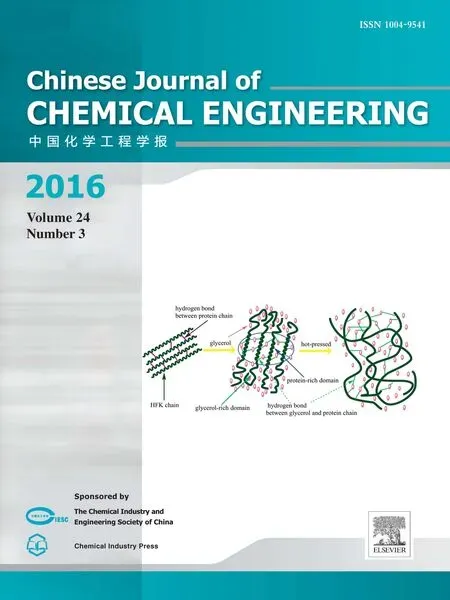 Chinese Journal of Chemical Engineering2016年3期
Chinese Journal of Chemical Engineering2016年3期
- Chinese Journal of Chemical Engineering的其它文章
- Influence of synthesis parameters on the properties of LiFePO4/C cathode material☆
- Controlled release and enhanced antibacterial activity of salicylic acid by hydrogen bonding with chitosan☆
- The structure,tensile properties and water resistance of hydrolyzed feather keratin-based bioplastics☆
- Preparation of dendritic bismuth film electrodes and their application for detection of trace Pb(II)and Cd(II)☆
- Wheat straw pretreatment with KOH for enhancing biomethane production and fertilizer value in anaerobic digestion☆
- Biodiesel synthesis via metal oxides and metal chlorides catalysis from marine alga Melanothamnus afaqhusainii
